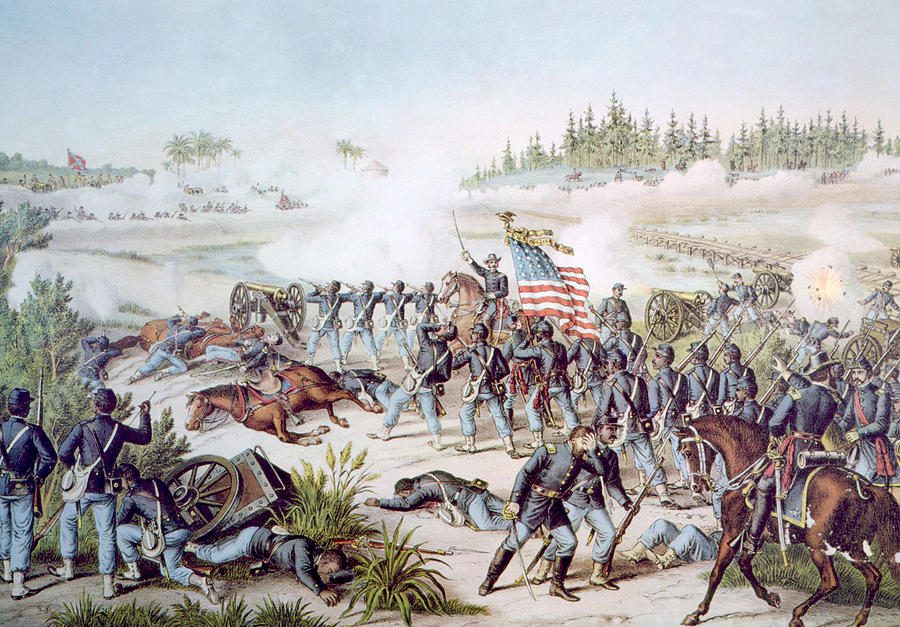
After the Emancipation Proclamation issued in January 1863, some of the Northern states, followed by the federal government, started to recruit and train regiments of Black troops to support the Union effort. One of the first, and indisputably the most storied of the Black regiments, was the Massachusetts 54th Volunteer Infantry. It was raised and trained between February and late May 1863. On May 28, 1863, it marched through Boston to a transport ship at the harbor, with thousands lining the streets to watch it go. The story is told that as the regiment marched past the Old State House—site of the Boston Massacre, where the first to fall was a Black man—they sang “John Brown’s Body.”
The 54th first experienced combat on July 16, 1863, at Grimball’s Landing, South Carolina, outside of Charleston, followed closely by a bloody assault on Fort Wagner, in Charleston Harbor. The 54th suffered a catastrophic 270 casualties out of the 600 men who participated and lost its commanding officer, Col. Robert Shaw. Although the assault was unsuccessful, the bravery of the 54th in battle was widely recognized and helped spur the formation of additional Black regiments. By the end of the war almost 200,000 men of color had served, comprising roughly 10% of the soldiers who served in the Union forces during the Civil War.
Five Black men who were born or lived in Hingham served in one of Massachusetts’ Black regiments: David Henry Champlin, Jason Prince, and Lewis Legare Simpson served in the 54th; Samuel F. Beach served in the 55th Volunteer Infantry; and Augustus Tuttle served in the 5th Colored Cavalry. Here is a little more about them.

David H. Champlin was born in Norwich, Connecticut on April 18, 1835 to Prince and Mary Champlin. We know little about his family except that Champlin’s father was “foreign.” By 1850, when Champlin was 15 years old, he was living with the family of James Chandler, a white shoemaker in Duxbury. Champlin went on to become a shoemaker, so he may have been apprenticed to Chandler. In any event, by 1860, Champlin was living in Hingham with a first wife, Hannah, and working as a shoemaker.
Champlin enlisted in the Massachusetts 54 th on August 25, 1863. Thus, like Lewis L. Simpson and Jason Prince, he joined after the momentous assault on Fort Wagner. He served as a Private in its Company B until March 1864, when he was promoted to the rank of Corporal. (Black men were eligible to become non-commissioned officers only, with the higher ranks open only to white men.) During this period, Company B did participate in a significant campaign in Florida, including the Battle of Olustee, and also at the Battles of Honey Hill, Georgia, and Boykin’s Mill, South Carolina. Champlin was mustered out with the rest of the regiment on August 20, 1865, at Mount Pleasant, South Carolina.
After the war, Champlin returned to Hingham, his family, and his work as a shoemaker. His second wife, Phebe, was the daughter of John and Margaret Quackow and the step-daughter of James Tuttle, founder of Hingham’s eponymous Tuttleville neighborhood, where Champlin and his wife settled: the 1880 federal census shows them living at 76 Ward Street. Champlin continued working in the shoe industry; in later records, he is listed an “operative,” meaning that he was no longer making shoes by hand but rather operating shoe-making machinery in a local factory.
Champlin died at age 50 of “dropsy,” a term sometimes used in the 19th century to describe what we would call congestive heart failure. He is buried in Fort Hill Cemetery; his grave is marked by a government-issued gravestone marked, “Corp. D. H. Champlin.”

Born in Hingham on April 16, 1843, Lewis L. Simpson was one of the 14 children of George Whitney Simpson and Eliza (Freeman) Simpson. He was, on his mother’s side, the great-grandson of a Revolutionary War soldier, Asher Freeman, a Black man who served in the Continental Army from 1777 to 1781. Simpson’s sister Henrietta married James King Tuttle, becoming a matriarch of Hingham’s families of color in the Tuttleville neighborhood.
Simpson enlisted in the Massachusetts 54th on November 29, 1863, aged 20, and served as a Private in Company G. One year after enlisting, November 30, 1864, he was wounded at the Battle of Honey Hill, Georgia, an attempt to disable the Charleston and Savannah Railroad in support of General William T. Sherman’s “March to the Sea.” After six months in military hospitals in Beaufort, South Carolina; David’s Island, New York; and Worcester, Massachusetts, Simpson was discharged from service on May 25, 1865. A bullet lodged in his ankle was never removed and bothered him for the rest of his life.
After the war, Simpson resumed his work as a bootmaker. He had married Maria D. Johnson before the war, and they settled in Bridgewater, raising four daughters and six sons. He was active in GAR activities and reunions of soldiers of the Mass. 54th , including one held in Boston in 1913 to celebrate the 50th anniversary of Fort Wagner. Simpson died in Bridgewater in 1918 and is buried in Mount Prospect Cemetery.

Jason Prince was born in Marshfield in 1842, the son of Sylvester Prince of Marshfield and Nancy Simpson of Hingham. He spent his childhood in Marshfield with his family but by 1855, as a teenager, he was living with the Copeland family in South Scituate (now Norwell). William Copeland was a Black shipwright and perhaps Prince was apprenticed to learn this trade; however, by 1863, when he enlisted, he was identified in his enlistment papers as a “farmer.” Prince enlisted for a three-year term in the 54 th on August 25, 1863—the same day as David Champlin. He was 21 years old and served as a Private in Company G for his entire tour of duty. He joined his regiment at Morris Island, South Carolina, on Nov. 29, 1863; was injured at the Battle of Olustee, in Florida, on Feb. 20, 1864; and was discharged owing to disability from the Union Army Hospital at Beaufort, SC, on June 8, 1865.
Prince returned to Massachusetts and in 1865 was living in South Scituate. At the time of his death, however, he was a Hingham resident. The Hingham Journal of April 22, 1881 reported a workplace accident at the J. W. Kimball lumber yard: Jason Prince of South Hingham had fallen from a pile of lumber. While the prognosis at first was hopeful, he had injured his spine. Paralysis set in and he died on May 1, 1881. The death notice in the May 13, 1881 HinghamJournal noted that Prince had been “a solder of the 54th Reg Mass Vol.” Prince is buried in High Street Cemetery.

Richard S. Winslow (1831-1904)
Richard S. Winslow was born on July 9, 1831 to Harvey and Clarissa Winslow, who resided at the time at 15 Ship Street, Hingham. Like Lewis Simpson, Winslow was descended from a Revolutionary War soldier—his great-grandfather Benjamin Ward of Hingham served with the militia in the early years of that war.
Winslow married Almira Franks, who was also born in Hingham, in 1851; she died in 1860. His second wife was Prudence Celia Lee of South Scituate, with whom he had twelve children. Winslow was 33, married, and the father of three when he enlisted in the 54th on December 10, 1863. His enlistment papers describe him as 6’2” and a shoemaker by trade. During his service as a private in Company H, Winslow saw action at Olustee, Florida and Boykin’s Mill, South Carolina—the last battle in South Carolina and one of the last of the war. After hostilities ceased, Winslow was “accidentally wounded in the foot” at Sumpterville, South Carolina and was mustered out of service on September 1, 1865 in New York City.
After the war, Winslow and his family lived in Hanover, where he died at age 73 in 1904. His obituary mentioned his service with the Mass. 54th, his later active involvement with Hanover and Plymouth GAR posts, and his membership in Hanover’s Methodist Church. Winslow is buried in the Center Hanover Cemetery.

Samuel F. Beach (1836-1871)
Samuel F. Beach was born in Hingham in 1835, the son of Michael and Harriet (Simpson) Beach. As a young man, his family moved around the area; he lived in South Scituate in 1850, Plymouth in 1855, and Duxbury in 1860. In the 1860 federal census, he is listed as a “farm laborer.”
Beach enlisted in the Massachusetts 55th Volunteer Infantry (the second Black infantry unit raised by the Commonwealth) on January 9, 1865. In February 1865, the Mass. 55th was one of the Union regiments that entered Charleston, where they were met with enthusiasm by crowds of newly-liberated Black slaves and free Black Charlestonians. The 55th remained in South Carolina for the rest of the war, largely engaged in occupying Charleston, before returning to Massachusetts in September 1865.
After the war, Beach settled in Salem, where he married Ann Thompson, and had a daughter, Emma, who was born in 1866. He continued to work as a general laborer, living to age 86. Beach died of pneumonia in 1871.

Augustus Tuttle (1835-1911)
Augustus Tuttle was born in Hingham in 1835, the son of John Tuttle and Harriet N. (Davis) Tuttle, but raised by his mother in Salem. In 1858, he married Mary Elizabeth Pitts Lewis of Lowell, who died the following year.
On August 31, 1864, Tuttle enlisted in the 5th Massachusetts Colored Cavalry, the only Black cavalry regiment mustered in Massachusetts. Company M, in which Tuttle served as a Private, was the last company of the 5th Colored Cavalry to be formed and the last to be mustered out, having been sent to Texas after the war was over.
Tuttle’s military records render his last name as “Tuthill” and provide his occupation as “barber.” After the war, on May 1, 1866, he married Elizabeth Ann Lew. The couple lived in Charlestown and then Cambridge. He was listed in an 1883 Boston City Directory as a “hairdresser” with a shop at 25 Derne Street, on Beacon Hill, and a home in Cambridgeport. Twice a widower, Tuttle died in Chelsea in 1911.



Excellent article, Paula! Amazing research! Thank you!!
So interesting! And someythng I surely didnt know about!
Janna Oddleifson